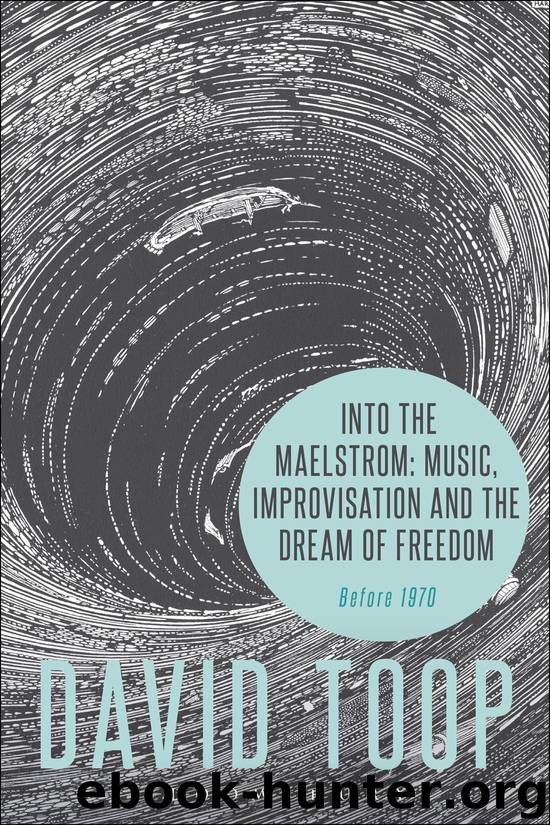Into the Maelstrom: Music, Improvisation and the Dream of Freedom by Toop David

Author:Toop, David
Language: eng
Format: epub
Publisher: Bloomsbury USA
Despair to hope
Already, by the 1960s free improvisation was splitting into two sharply divergent philosophical positions, both adamant that their methodology was the true path to complete freedom. On the side of preparedness was a conviction that only the highest levels of musical virtuosity made it possible to follow each imaginative flight (the line followed by Lennie Tristano, Joe Harriott, later Keith Jarrett). From the other side was a belief in deconditioning: forget musicality and training; cleave instead to holy fools and children; splatter, scream, rattle among the everyday (the strategy of Group Ongaku, Dubuffet and Jorn).
For the latter group, the years of training and experience obligatory to jazz was problematic, an impediment to spontaneity. ‘Despair To Hope’ recorded by trumpeter Don Ellis, was an example of the reason why. Ellis had worked in swing bands including the Glenn Miller Orchestra, then found himself as an adept young trumpet player inside the advanced theoretical school of George Russell. He played alongside Eric Dolphy and Steve Swallow on Russell’s Ezz-thetics album in 1961, a record notable for many reasons, not least the unorthodox version of Thelonious Monk’s ‘Round Midnight’, prefaced by an introduction which sounds freely improvised: sweeping of the piano strings, the animal cries of the brass lurking in the shadows of studio echo, percussive bass, a vivid image of night creatures out of which rises Eric Dolphy’s impassioned alto saxophone solo.
In the same year, Ellis released New Ideas under his own name, an album for which he brought together Al Francis on vibraphone, pianist Jaki Byard, Ron Carter on bass and drummer Charlie Persip. ‘Despair To Hope’ was a free improvisation – free from regular time, chords or head arrangement though not free from trite psychological drama – in which random percussive actions form a backdrop for Ellis to come out of those reverberant shadows. Small objects – coins, maybe, or pellets – are dropped, rattled, shaken close to the microphone. Al Francis uses vibraphone to suspend the mood in its shimmer. A larger object is thrown to the floor. Small finger cymbals are rubbed together. When Ellis stops playing he breathes melodramatically, following that with cartoonish glissandi on trumpet and swanee whistle. The piece ends with a stick rubbed along a ridged surface.
Ellis was an experimental thinker, an innovator with wide interests whose work would become widely known through his big bands later in the 1960s, their compound time signatures and Indian influences (he studied with Harihar Rao, a sitar teacher in the ethnomusicology department at UCLA), and then his score for The French Connection. Some background in free improvisation is useful in those settings – the open environment in which to work with sonorities, textures, odd combinations, unorthodox instrumental techniques – but despite or because of his virtuosity Ellis was too prone to lapse into cliché to survive more than a few minutes of free improvisation, too ambitious to dwell for long on such a precarious economic precipice. By 1970 his free phase was but a faint memory.
Download
This site does not store any files on its server. We only index and link to content provided by other sites. Please contact the content providers to delete copyright contents if any and email us, we'll remove relevant links or contents immediately.
The Goal (Off-Campus #4) by Elle Kennedy(13213)
Kathy Andrews Collection by Kathy Andrews(11346)
Diary of a Player by Brad Paisley(7272)
What Does This Button Do? by Bruce Dickinson(5938)
Assassin’s Fate by Robin Hobb(5867)
Big Little Lies by Liane Moriarty(5528)
Altered Sensations by David Pantalony(4878)
Pale Blue Dot by Carl Sagan(4633)
Sticky Fingers by Joe Hagan(3918)
The Death of the Heart by Elizabeth Bowen(3350)
The Heroin Diaries by Nikki Sixx(3328)
Beneath These Shadows by Meghan March(3157)
Confessions of a Video Vixen by Karrine Steffans(3110)
The Help by Kathryn Stockett(3024)
How Music Works by David Byrne(2969)
Jam by Jam (epub)(2882)
Harry Potter 4 - Harry Potter and The Goblet of Fire by J.K.Rowling(2818)
Strange Fascination: David Bowie: The Definitive Story by David Buckley(2704)
Petty: The Biography by Warren Zanes(2579)
